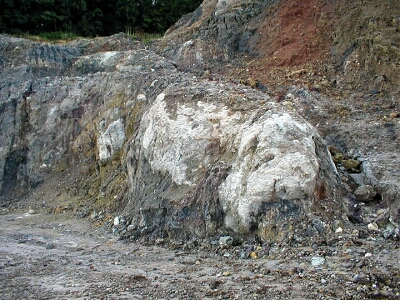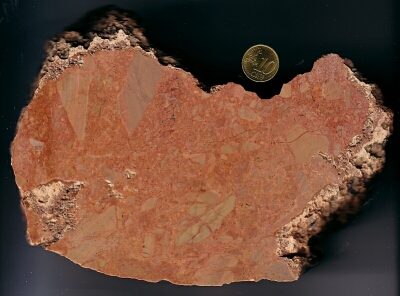accretionary lapilli
Pellets that form by the accretion of fine ash around condensing water droplets or solid particles, particularly in steam-rich volcanic eruptive columns. Similar processes are related with the turbulent explosion plume raising above the expanding excavation cavity in an impact cratering event. So, accretionary lapilli that commonly exhibit a concentric internal structure, have been found also in impact deposits. See http://www.impact-structures.com/Archiv/archiv.html
acoustic fluidization
Hypothesized (H.J. Melosh) fluidization of rock debris subjected to strong vibrations possibly enabling the collapse of the transient crater in the modification stage of impact cratering.
asteroid
Cosmic body in the asteroid belt between the orbits of Mars and Jupiter. The largest asteroid, Ceres, has a diameter of roughly 1,000 km. Asteroids from Earth-crossing orbits are potential impactors.
astrobleme
"star wound"; crater formed by meteorite impact.
ballen structure
Microscopic shock-deformation feature in quartz. Oval quartz with rims of tiny vugs filled with amorphous material.
ballistic erosion and sedimentation
(Oberbeck 1975) Emplacement of ballistically transported impact ejecta, and ejecta-surface interaction.
biotite
See mica.
bolide
"Fire-ball"; meteor exploding in passing through the Earth's atmosphere.
breccia
A clastic sedimentary rock composed of angular clasts in a consolidated matrix. Breccias can be produced in several geologic processes: tectonic breccia, volcanic breccia (eruption breccia, vent breccia), sedimentary breccia (e.g., rock fall breccia), collapse breccia (e.g., in karst areas). Depending on the origin of the clasts, monomictic (monogenetic, monolithologic) and polymictic (polygenetic, polylithologic) breccias may be distinguished. See impact breccia.
breccia dike
Bunte breccia
(= multicolored breccia; local name) Impact ejecta deposit of the Ries impact structure (Germany). See Image.
Bunte breccia
calcite
calcium carbonate mineral, CaCO3. Major constituent of carbonate sedimentary rocks, e.g., limestone.
Canyon Diablo crater
See Meteor crater
cataclasite
Rubble breccia formed by shearing and granulation in dislocation metamorphism. Also see monomict(ic) breccia.
central peak
see central uplift
central uplift
Structural elevation (central peak) in complex impact structures. Originates from elastic rebound and transient-crater collapse in the modification stage of impact cratering.
Chicxulub impact structure
Large buried impact structure in the Yucatan (Mexico) region that formed at the Cretaceous-Tertiary (K/T) boundary 65 Ma ago. The Chicxulub impact is generally assumed to be the main cause of the K/T mass extinction.
coesite
high-pressure polymorph of quartz (SiO2). Found in impact rocks and in rocks subjected to extreme regional metamorphism.
cone-in-cone structure
Diagenetic conical structure in rocks in general made from calcium carbonate. Sometimes confused with shock-produced shatter cones.
comet
Cosmic body in a parabolic or highly elliptical orbit around the sun. Composed of meteoric dust and frozen C, O, H -compounds. Comets are potential projectiles in impact cratering. In 1994, the torn Shoemaker-Levy 9 comet impacted Jupiter. Cometary impacts have been discussed to have brought building blocks of early life to the Earth.
complex impact structure/crater
An impact structure exhibiting a central uplift and/or inner rings that are formed by elastic rebound and slumping of the walls of the transient crater in the modification stage. The transition from simple to complex craters depends on the gravity of the impacted planetary body. On Earth, complex craters have diameters of roughly more than 4 km. Also see simple impact structure/crater.
contact and compression stage
First stage in the impact cratering process. On contact of the projectile (impactor) with the target, both become highly compressed leading to shock waves that move into both the target rocks and the projectile. The extreme temperatures in the shock fronts are enough to completely vaporize the projectile and a comparable volume of the target rocks.
crater chain
see impact crater chain.
cryptovolcanic structure
Term used especially in the twenties and thirties and assigned to terrestrial circular structures that showed heavy destructions of rocks evidently produced by a tremendous underground explosion. Because of the absence of any volcanic activity in many of these structures (e.g., Steinheim, Serpent Mound, Decaturville, Wells creek, Kentland), a muffled or hidden volcanism was suggested (especially by the American geologist W. H. Bucher). Later, these structures proved to be impact structures.
Darwin glass
Impact glass found in the environs of the 1.2 km-diameter Darwin impact crater in western Tasmania, Australia.
decorated PDFs
Planar deformation features (PDFs) decorated by fluid and/or mineral inclusions as the result of annealing.
deformation twinning
Lattice gliding due to stress subjected to a crystal. Twinned crystals may show deformation lamellae. Twinning in crystals may be caused by shock deformation. See microtwinning in calcite.
diamond
The crystalline form of carbon (C) is the hardest naturally occurring material. May be formed in meteorite impact when carbon, e.g. in graphite-bearing rocks, is subjected to extraordinarily high temperatures and pressures. Is observed in meteorites and impactites (e.g., Ries, Popigai impact structures).
diaplectic crystal
Partly isotropic crystal originating from patchy shock damage of the crystal lattice (see Image).
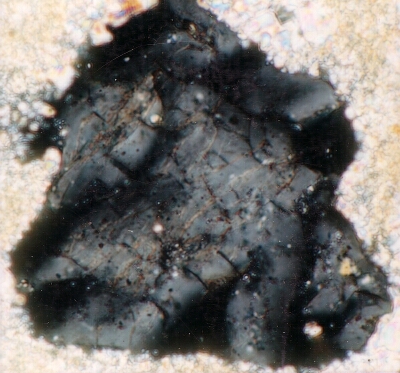
Diaplectic quartz crystal under the polarization microscope. Photomicrograph, crossed polarizers.
diaplectic glass
Glass formed by shock damage of a mineral and not by melting. According to current knowledge, diaplectic glass cannot be formed in endogenetic processes.
dike breccia
dislocated megablock
In and around impact structures large allochthonous block of coherent stratigraphy.
Earth-crossing asteroid
See asteroid.
ejecta
See impact ejecta.
ejecta blanket
See impact ejecta.
ejecta curtain
Impact-excavated clasts ejected ballistically on parabolic trajectories combine into a cone-shaped curtain, the ejecta curtain, expanding outward from the crater rim and turning into the ejecta blanket around the crater.
elliptical impact crater
Elongated impact structure that was formed by very low-angle oblique impact or by a disintegrated, torn impactor.
elastic rebound
Part of a theory explaining the forces that cause earthquakes. In impact cratering , elastic rebound describes the readjustment of the highly compressed floor of the transient cavity in the modification stage.
excavation stage
Second stage in impact cratering following the contact and compression stages. Rock mass-flow behind the expanding shock front produces a likewise expanding excavation crater. Ejection of excavated rock masses and maximum dimensions (diameter and depth) of the excavation crater define the transient crater.
feldspars
Group of rock-forming silicate minerals. Feldspars are good indicators of shock metamorphism.
fullerenes
Carbon molecules of the form C60, C76, C84 ... that may trap gases in their soccer ball-shaped structure. Extraterrestrial gases in fullerenes found in terrestrial rock deposits have been related with impact events, e.g., extraterrestrial helium trapped in fullerenes in the Sudbury impact
structure, and extraterrestrial noble gases in fullerenes at the Permian-Triassic boundary.
geology
Science of the study of the accessible parts of the Earth's crust, their rocks, their structures,their fossils and their resources with the aim to get a picture of the development of the planet and the life on it. So, geology is partly a historical science and partly a natural science. Although "geo" means earth, the term geology is used also with the study of other planetary bodies, e.g., planetary geology, geology of the Moon. Impact cratering, for a long time unknown to geologists, is now the title of a textbook in geology: Impact Cratering - a Geologic Process, by H. J. Melosh.
geophysics
Physics of the Earth related with all aspects of physical properties, structures, and processes of the Earth (and other planetary bodies). Geophysics of impact structures comprises gravity, magnetic, seismic, geoelectric, and other measurements. Several buried impact structures have been detected by geophysical studies. See http://www.impact-structures.com/geophysic/geophysikimpakt.html
GPa
Gigapascal, 1 GPa = 1,000 MPa (Megapascal) = 109 Pascal, the SI unit of pressure. GPa is commonly used in the high-pressure range of shock deformation, 1 GPa = 10 kbar.
Grady-Kipp fragments
In an impact cratering model, the rock fragments resulting from tensile stress related with the rarefaction wave. See also impact spallation.
granophyre
Igneous rock with granitic composition. Also local term for an impact melt rock in the Vredefort impact structure, South Africa. See Image.
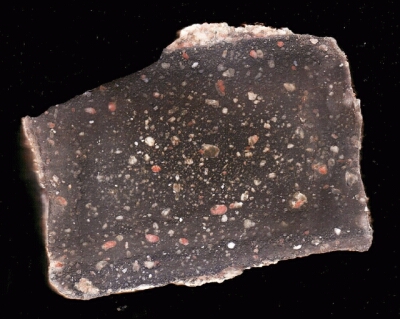
Granophyre, impact melt rock from the Vredefort impact structure; polished cut.
gravity studies
Gravimetry; geophysical method to measure variations of the gravity field related with subsurface density variations. Impact structures commonly show pronounced gravity negative anomalies (see Image) due to the occurrence of low-density breccias, rock fracturing, and replacement of ejected material by post-impact young sediments. In very large impact structures, relative positive anomalies may be produced by the uplift (see central uplift) of high-density material from the Earth's lower crust and upper mantle. See http://www.impact-structures.com/geophysic/geophysikgravimtrie.html

Gravity studies: gravity negative anomaly of the Ries impact crater (Germany)
gries (= gravel, grit),
German term especially used to describe a heavy monomictic grit brecciation in rocks of the Ries impact structure.
grit brecciation
Cataclastic deformation by shearing and granulation of hard (competent) rocks typically found in impact structures. Also see monomictic movement breccias.
Grit brecciation in the Rubielos de la Cérida impact basin.
Hugoniot equations
Also termed Hugoniot-Rankine equations, describing the behavior of material subjected to shock waves.
hypervelocity impact
Impact by a cosmic body at a velocity exceeding the sound velocity (velocity of elastic (seismic) waves) in the impacted target rocks (commonly around 5 km/s) leading to the spreading of shock waves.
igneous rocks
Group of rocks that have crystallized from a magma; e.g., granite, basalt. Also see sedimentary rocks and metamorphic rocks.
impact breccia
A breccia that is formed in an impact cratering process. See monomict(ic) impact breccia, polymict(ic) impact breccia, suevite breccia, monomictic movement breccia. Also see http://www.impact-structures.com/...... impactbrecciapage.html
impact breccia dike
A dike in the common geological sense is a mostly tabular body of different materials (minerals, rocks, ores) cross-cutting the host rock. In impact structures, breccia dikes have played an important role in the understanding of the impact cratering process. It is generally suggested that for the most part the breccia dikes are formed in the excavation stage by injection of brecciated material into the walls and the floor of the expanding excavation cavity. Later formations of breccia dikes in the modification stage incorporating earlier formed ones may lead to generations of breccia dikes. See http://www.impact-structures.com/...... impactbrecciapage.html
http://www.impact-structures.com/spain/impact/brecciadikes.htm
http://www.impact-structures.com/spain/rubie/Breccia.html
impact crater
A crater that originates from hypervelocity impact. See impact structure.
impact crater chain
A term commonly used when there are three or more lined up impact structures that have formed in a single impact event. Impressive impact crater chains exist on Jupiter's satellites Ganymede and Callisto. On Earth, a single Late Triassic impact event to have formed five individual structures (Rochechouart in France, Manicouagan and Saint Martin in Canada, Obolon' in Ukraine, and Red Wing in Minnesota) though spread over two continents, has been suggested. The Mid Tertiary Azuara impact structure in Spain and its nearby Rubielos de la Cérida companion crater are parts of a more or less continuous crater chain, the first of this kind known on Earth, of more than 100 km length. See http://www.impact-structures.com/spain/rubielos.htm
impact cratering
All aspects related with the formation of an impact structure: astronomical considerations, impactors, the stages of the crater-forming process, geological implications, impact rocks, shock metamorphism, impact experimental studies, scaling.
impact ejecta
Solid, liquid and vaporized material ejected from an impact crater. See
http://www.impact-structures.com/spain/impact/ejecta.htm
http://www.impact-structures.com/spain/rubie/ejecta.html
impact glass
Natural glass that originates from the quenching of impact melt.
impact melt
Melt formed by shock from meteorite impact.
impact melt rock
Melt rocks in impact structures that may result from shock melting and from frictional melting in strong dynamic metamorphism (see impact pseudotachylites). For the formation of total rock melts, shock pressures in excess of roughly 60 GPa (600 kbar) are required. According to the IUGS Subcommission on the Systematics of Metamorphic Rocks, Study Group for Impactites, impact melt rocks are crystalline, semihyaline or hyaline rocks which have solidified from shock-produced impact melt und which contain variable amounts of clastic debris. See Image: Granophyre. Also see http://www.impact-structures.com/melt/impactmeltpage.html
impact metamorphism
In the broader sense: changes of minerals and rocks acquired in the impact cratering process including shock metamorphism, pseudotachylite and shattercone formation. In the narrow sense: metamorphism of minerals and rocks caused by shock from meteorite impact.
impact pseudotachylite
A tachylite is a black volcanic glass formed by the chilling of basaltic magmas. Early geologists in Vredefort identified something like it and called it pseudotachylite. According to the IUGS Subcommission on the Systematics of Metamorphic Rocks, Study Group for Impactites, an impact pseudotachylite is a dike-like breccia which formed by frictional melting in the basement of impact structures and which may contain unshocked and shocked mineral and lithic clasts in a fine-grained aphanatic [aphanatic = very fine-grained, crystalline texture] matrix. Also see http://www.impact-structures.com/melt/impactmeltpage.html
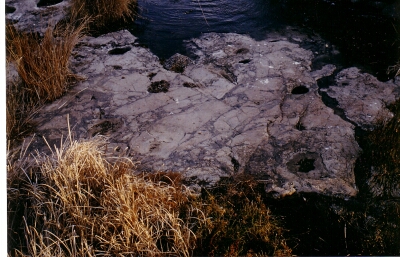
Impact pseudotachylite (the net of dark veins) in the Vredefort (South Africa) impact structure.
impact spallation
Sum of effects related with rarefaction waves in the impact cratering process. Near the free surface of the target where the rarefaction tensile stress is maximum, thin spall plates of rock are thought to be expelled at very high speed. Peculiar spallation effects may occur in conglomerates by multiple shock-wave reflections within spherically shaped clasts; see Image impact spallation. Also see http://www.impact-structures.com/spain/shocked/spallation.htm
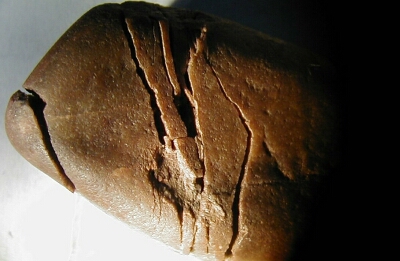
Impact spallation: open tensile fractures in a clast from shocked conglomerates; Rubielos de la Cérida impact.
impact structure
Often synonymous with impact crater, a geologic structure formed by asteroidal or cometary impact. Sometimes, impact structures are distinguished from impact craters by their weak morphological signature compared with a true crater. See Image Impact structure.
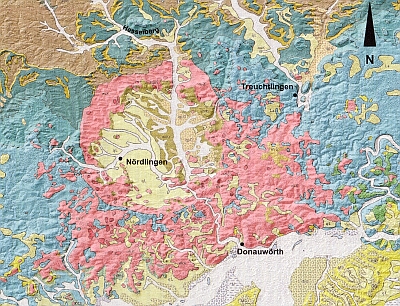
Impact structure: geological general map of the Ries crater superimposed on a digital topographical model. By courtesy of Bayerisches Geologisches Landesamt; E. Geiß.
impactite
A rock produced in the impact cratering process; e.g., shocked rock, impact breccia, impact melt rock, suevite (breccia).
impactor
The cosmic projectile in impact cratering.
interference zone
In impact cratering models, the near-surface of the target where compressional shock wave and tensional rarefaction wave interfere to reduce maximum pressure.
jetting
Ejection process postulated for the very early contact and compression stage of impact cratering. Many researchers believe that tektites originate from jetting of material extremely compressed in the impactor/target contact zone.
kbar
Kilobar, 1 kbar (1 kb) = 1,000 bar; unit of pressure, frequently replaced by the SI unit Pascal, Pa, and Gigapascal, GPa (1,000 kbar = 1 Mbar = 100 GPa). The hydrostatic pressure in the center of the Earth amounts to about 3,000 kbar. Shock pressures in the contact and compression stage of impact cratering may exceed this value.
kink band
Characteristic pressure deformation in minerals, most common in mica but also observed in quartz and other minerals. Kink bands are formed by pressure-induced gliding in the crystal combined with external rotation of the lattice. See Image. Kink bands are a typical shock effect but can originate also from very strong tectonic deformation.
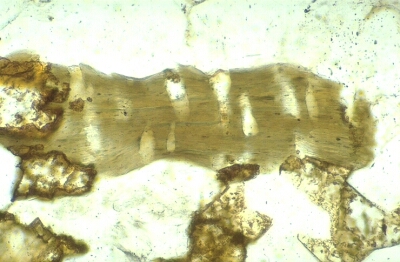
Kink bands in mica. Photomicrograph, plane light.
K/T boundary
Cretacious/Tertiary boundary (the C abbreviation is already assigned to the Cambrian system), at present practically synonymous with marking the giant mass extinction 65 Ma ago. The extinction of the dinosaurs at that time is only a subordinate part of this remarkable event. See Chicxulub impact structure.
lechatelierite
Fused silica glass SiO2. Lechatelierite has three different origins: Meteorite impacts, volcanism and lightning strikes (fulgurites). See Libyan desert glass.
lithic (impact) breccia
Polymictic impact breccia that contains shocked and unshocked clasts in a clastic matrix but lacks cogenetic melt particles. Also see http://www.impact-structures.com/...... impactbrecciapage.html
Libyan desert glass
High silica natural glass considered to be impact-related tektites.
magnetic studies
Geomagnetic studies. Geophysical method to measure variations of the Earth's magnetic field related with rocks of different magnetic properties. Magnetic anomalies in and around impact structures may result from displacement of magnetized rocks in the impact cratering process, decomposition of existent rock magnetization (by shock, for example), and formation of new magnetic phases in rocks (e.g., by chemical alterations, by acquiring a thermal remnant magnetization). See http://www.impact-structures.com/geophysic/geophysikmagnet.html.
Mars meteorites
Meteorites (SNC meteorites) that are thought to have been ejected from Mars by large impacts.
maskelynite
diaplectic feldspar (plagioclase) glass.
mass extinction
Extinction of many groups of organisms at a particular time by environmental catastrophe related with collapsing ecosystems. There are strong indications that some mass extinctions may be caused partly or completely by large asteroidal or cometary impacts. See K/T boundary.
megabreccia
Extensive breccia containing very large components. Megabreccias are a typical feature in and around impact structures. Perhaps most impressive is the Late Devonian Alamo megabreccia giving evidence of a giant offshore impact.
Also see http://www.impact-structures.com/spain/rubie/megabr.html
http://www.impact-structures.com/spain/controversy/megabrecha.htm
metamorphic rock
Rock that was formed by the recrystallization of a pre-existing rock in response to a change of mainly temperature and pressure (metamorphism). Metamorphic rocks are, e.g., marble (metamorphic limestone), gneiss, schist. Also see shock metamorphism.
metamorphism
See metamorphic rock.
meteor, meteoroid, meteorite
A meteoroid is a small extraterrestrial body that may enter the Earth's atmosphere. On entering the atmosphere, the incandescence due to friction is called a meteor (see bolide). A meteorite is a meteor that survived the passage through the atmosphere and lands on the Earth's surface. See meteorite crater.
Meteor crater
Called also Barringer crater, Arizona crater, Coon Butte, Canyon Diablo crater, Crater Mound. 1,200 m-diameter and 175 m-depth impact crater within the Colorado Plateau in Arizona, USA. Archetype of a meteorite crater. At the end of the 19th century, Meteor crater marks the beginning of the bitter controversy about the cosmic or endogenetic origin of terrestrial craters and ring structures. See also cryptovolcanic structure.
Meteorite
International Quarterly of Meteorites and Meteorite Science. Also see meteor, meteoroid, meteorite
meteorite crater
Crater that formed by the impact of an extraterrestrial body. When formed by hypervelocity impact, synonymous with impact crater.
Meteoritics & Planetary Science
Journal of the Meteoritical Society, an international society.
micas
Group of sheet-silicate minerals; e.g., muscovite, biotite. Kink bands in mica may be produced by shock.
microbreccia
Very fine-grained breccia.
microtwinning in calcite
Deformation twinning in calcite on a microscopic scale. Multiple sets of microtwins in calcite are considered diagnostic of shock deformation.
modification stage
Third stage of impact cratering assigned to the modification of the transient crater after excavation and ejection. In this stage, small craters (see simple crater) undergo only slight modifications. Collapse of large transient craters by elastic rebound and slumping of the crater walls leads to the formation of complex impact structures with central uplifts, inner rings and terraced walls.
Moldavite
Tektite related with the Ries impact structure.
monomict(ic) breccia
Results from rock deformation by shearing and granulation (cataclasis) in the process of tectonism or - more general - dislocation metamorphism. If the dislocation metamorphism is impact-related, the produced cataclasite may be termed a monomict impact breccia. See http://www.impact-structures.com/...... impactbrecciapage.html
monomictic impact breccia
See monomictic breccia.
monomictic movement breccia
Originates from drastic brecciation of whole rock complexes with resulting grain sizes down to sand and silt fraction. Frequently, preserved fitting of the fragments is observed. This peculiar brecciation requires intense movement under very high confining pressure. The typical brecciation texture occurs in excavated megablocks, in the floor, in inner rings, and in the central uplift of impact structures. In rare instances, this type of brecciation may be observed in tectonic fault zones, but it is typical also of breccias from giant rock falls.
See http://www.impact-structures.com/...... impactbrecciapage.html
http://www.impact-structures.com/spain/rubie/Monomictic.html
Monomictic movement breccia with mortar texture.
Moon meteorites
Meteorites that are thought to have been ejected from the Moon by large impacts.
mortar texture
Term commonly used to describe a recrystallization texture in rocks subjected to dynamic metamorphism. More general, it is a texture found in monomictic movement breccias. It is characterized by polyhedrically shaped rock fragments floating in a fine-grained sandy to powdery matrix - like building stones embedded in a mortar. See Image Monomictic movement breccia.
mosaicism
Shock feature in mineral crystals. Under crossed polarizers of the polarization microscope, mosaicism shows as a checkered, mosaic-like extinction pattern resulting from shock-induced disorder in the crystal lattice.
multiple impact
Synchronous impact of two (paired impact) or more impactors. A Late Triassic multiple impact has been proposed to have produced a chain of five large impact structures on the European and the American continents. A Mid-Tertiary multiple impact has been reported for the northern Iberian Peninsula (Azuara - Rubielos de la Cérida multiple impact and crater chain; see www.impact-structures.com). Multiple impacts are observed also on the Moon, Mars, Venus and on Jupiter's satellites Ganymede and Callisto.
multi-ring impact structure
Multi-ring basin. Large impact structure exhibiting a system of concentric rings; e.g., Orientale on the Moon, Caloris on Mercury. The formation of multi-ring basins is disputed. The tsunami theory, proposed by R.B. Baldwin, suggests a kind of fluidization of the target area which behaves hydrodynamically and enables the radiation of tsunami-like waves.
muscovite
See micas.
Oort cloud
Cloud of comets hypothesized to be the source of the long-period comets. Periodical disturbance of the Oort cloud has been proposed to be related with a disputed periodical increase of cometary impacts on the Earth (Shiva theory).
overturned strata ("overturned flap")
Inverse stratigraphy at an impact crater rim related with the excavation process.
PDFs
See planar deformation features
peak-ring craters
Larger impact craters on the Moon where the central uplift of smaller craters is replaced by a peak ring. The transition occurs at a diameter of roughly 140 km.
petrography
Systematic description of rock texture and composition.
petrology
The science of the study of rocks.
PFs
See planar fractures.
planar deformation features
PDFs. Planar shock deformations in minerals (quartz, feldspar, and others); closely spaced isotropic lamellae following crystallographic planes. According to current knowledge unknown from any endogenetic geologic process. See decorated PDFs. See Image.
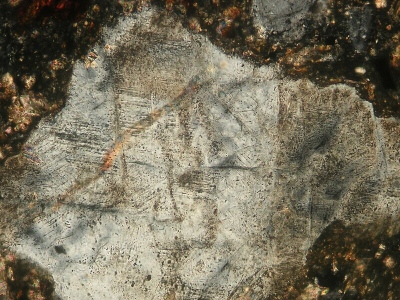
Planar deformation features (PDFs) in quartz. Photomicrograph, crossed polarizers.
planar fractures PFs.
Cleavage. Fractures in minerals following crystallographic orientations. In quartz crystals, PFs (cleavage) is practically unknown and originates in rare instances from tectonic deformation in very strong regional metamorphism. On the other hand, PFs in quartz are an indicator of shock metamorphism. See Image PFs in shocked quartz.
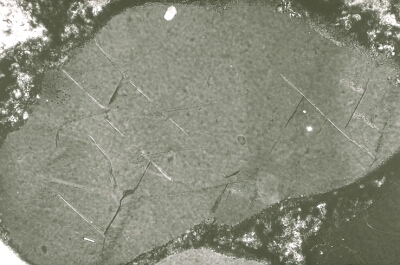
Planar fractures in shocked quartz. Photomicrograph, crossed polarizers.
polymict(ic) breccia
Breccia composed of mixed clasts of different lithology and origin. See Image. Also see http://www.impact-structures.com/...... impactbrecciapage.html
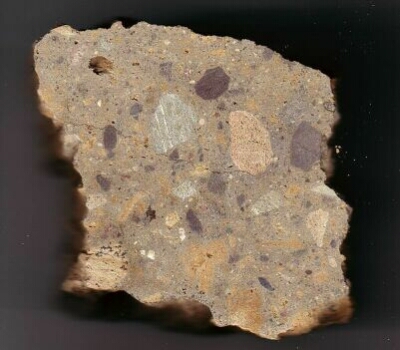
Polymict(ic) breccia.
photomicrograph
Photograph taken by the aid of an optical microscope.
polarization microscope
Optical microscope enabling the study of rock thin sections by polarized light (in plane polarized light and with crossed polarizers).
pseudotachylite
quartz
Rock-forming silicate mineral SiO2. Quartz is a sensitive indicator of shock metamorphism.
rarefaction wave
Tensional wave originating from the reflection of a compressional wave at a free surface or at a boundary of material of reduced impedance (impedance is the product of density and sound velocity). In impact cratering, rarefaction (tensional) waves play an important role. They are formed when the compressional shock waves are reflected back downwards from the free surface of the impacted target. Combined with the rock mass flow behind the shock front, they determine the excavation flow field. Because the tensile strength of rocks is always much lower than the compressive strength, rarefaction waves are in general more destructive than the compressional shock waves (see Grady-Kipp fragments). On a smaller scale, rarefaction may lead to characteristic spallation effects in shocked rocks.
scaling
Theoretical and experimental study of impact-cratering energy and size relations.
scanning electron microscope SEM.
Microscope using emitted and object-reflected electrons. Magnifications of up to 100,000 times are possible. Makes three-dimensional structures of minute objects visible. See Image Scanning electron microscope.

Scanning electron microscope. SEM image of the interior of vesicular silicate impact glass.
secondary craters
Craters that are formed by the landing of high-speed impact ejecta.
sedimentary rock
Rock formed by the deposition and solidification of rock and mineral particles, e.g., sandstone, limestone, claystone.
SEM
See scanning electron microscope.
shatter cone
Shattercone. Macroscopic shock feature in impact structures. Shock-produced conical fracture exhibiting characteristic horse-tail fracture markings. The size of individual cones ranges from less than one centimeter to more than one meter. The apices of the cones tend to point towards the shock source - however, take a look at the Image shatter cones in limestone. Also see http://www.impact-structures.com/shattercone/shatterconepage.html . Also see cone-in-cone structure.
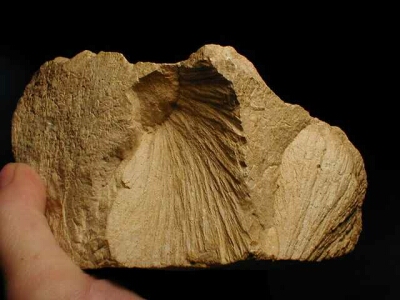
Shatter cones (positive and negative) in limestone.
Shiva theory
See Oort cloud
shock
Shortened form of "deformation by shock waves", "shock effect", "shock metamorphism".
shock effect
Change in rocks and minerals due to the passage of shock waves. See shock metamorphism.
shock front
Front of a shock pulse from hypervelocity impact propagating into the target rocks (and into the impactor). In the shock front, rock ambient pressures and temperatures are rapidly raised to shock pressures and temperatures which may attain to several 100 Gigapascal (GPa) and several 10,000 Kelvin (K) near the impact point.
shock wave
In a material, a shock wave is a deformation, a non-elastic wave that moves at a velocity exceeding the sound velocity of that material. The sound or seismic velocity is defined by the propagation of elastic waves. Shock waves are produced in hypervelocity impact and are the cause of shock metamorphism in rocks and minerals.
shock metamorphism
Permanent changes in rocks and minerals subjected to shock-wave passage. Progressive stages of shock metamorphism are:
very weakly shocked - weakly shocked (e.g., planar fractures in quartz and feldspar, kink bands in mica; shock pressure very roughly 10 GPa, post-shock temperature very roughly 100°C) - moderately shocked - strongly shocked (e.g., PDFs, diaplectic glass; 60-70 GPa, 1,000-2,000°C) - very strongly shocked - shock melted (whole rock melting; roughly > 80 GPa, > 2,000°C). Also see http://www.impact-structures.com/spain/rubie/Shock.htm,
http://www.impact-structures.com/spain/impact/shockeffects.htm
Shoemaker, Eugene Merle (1928-1997)
American geologist and astronomer, who pioneered the study of impact cratering on Earth, on the Moon, and on the other planets and their satellites.
Shoemaker-Levy 9
Disrupted comet discovered in 1993 by E.M. Shoemaker, his wife Carolyn, and David Levy. Spectacular crash with Jupiter in July 1994.
simple impact structure/crater
A bowl-shaped crater having undergone only slight modifications of its transient crater. Meteor Crater is the epitome of a simple impact structure. See complex impact structure/crater.
spallation
See impact spallation.
spall plates
See impact spallation.
spherule layers
Sedimentary beds of spherulitic bodies originating from the condensation of impact-produced rock vapor clouds.
stishovite
High-pressure polymorph of quartz (SiO2) found in impact rocks as the result of shock metamorphism.
structural geology
See tectonics.
suevite, suevite breccia
A polymict impact breccia composed of fragments more or less shocked, and melt clasts in a clastic matrix. Originally, suevite was the name of a melt breccia in the Ries crater and derived from the name for the province of Swabia in southern Germany. For decades, the Ries crater suevite was considered a peculiar volcanic breccia and unique in the world. Both the volcanic origin and the uniqueness had to be abandoned when the Ries suevite was shown to be a strongly shocked impactite, and when comparable rocks were found in many other impact structures worldwide. See Image. Also see http://www.impact-structures.com/suevite/the_suevite_page.htm
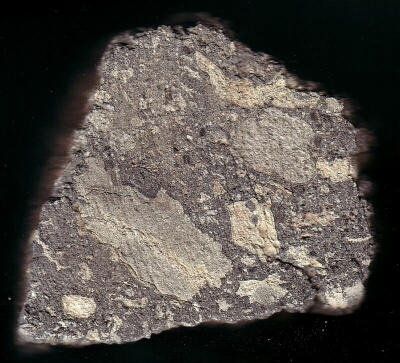
Suevite, Ries impact structure
tagamite
Russian term for impact melt rock.
target, target rocks
Area and rocks exposed to the impacting projectile.
tectonics
1. Study of the structure of the Earth's crust and of the forces and movements related with rock deformation. Synonymous with structural geology.
2. descriptive term: e.g., the tectonics of the Appalachian orogenic belt.
tektites
natural glass bodies of small size (usually few centimeters), mostly aerodynamically shaped, scattered over large areas (so-called strewnfields), and evidently related with large impacts (e.g., Ivory Cost tektites and Bosumtwi impact structure, Moldavites and Ries impact structure). The source for the large Australasian tektite strewnfields (e.g., australites, indochinites, philippinites (= rizalites)) is unknown so far. Microscopic tektites (microtektites) have been sampled from ocean sediment drill cores. The process of tektite formation is disputed, but many researchers believe that they are formed in the early contact and compression stage of impact cratering. See jetting.
TEM
See transmission electron microscope
thin section
A slice of a rock or mineral ground down to a thickness of about 30 µm (= 0,03 mm). At this thickness, light may be transmitted through the section, which enables the study by the polarization microscope.
transient crater
The crater that exists at the end of the excavation stage of impact cratering. The transient crater undergoes only slight modification in the case of a small, bowl-shaped crater. Large transient craters exhibit a gravity-dependent instability which leads to its collapse by elastic rebound and slumping of the walls and, to a large extent, to filling up of the cavity. Consequently, these complex impact structures/craters show a much smaller depth-to-diameter ratio compared with simple, bowl-shaped craters. See modification stage, simple impact structure/crater.
transmission electron microscope TEM.
A microscope having similar pattern like an optical microscope but using electrons instead of light. Operating at atomic scales.
tsunami theory
A theory of multi-ring formation in giant impact structures. See multiple-ring impact structures.
Tunguska event
A tremendous explosion in the atmosphere over the northern Russian taiga in 1908 related with heavy destructions on the ground, strong seismic waves and a succession of abnormally light nights during the following weeks. The nature of the object and its explosion have been disputed, but most researchers consider the explosive disintegration of a small asteroidal or cometary body to be the most probable explanation. An impact crater does not exist.
undulatory (or undulose) extinction
Wavy extinction pattern seen in thin sections of minerals by the rotation of the stage of the polarization microscope (crossed polarizers). The undulatory extinction is explained by plastic deformation having slightly modified the crystal orientation. Abundant in tectonically deformed rocks, but also common in weakly shocked minerals.
Wegener, Alfred (1880-1930)
A German meteorologist and geophysicist best known for his work on continental drift. Less well known are his studies of the craters of the Moon and his support of their impact origin: Alfred Wegener, Die Entstehung der Mondkrater [The Origin of the Lunar Craters] (Braunschweig, Germany: Friedr. Vieweg & Son, 1921).
Z-model
Maxwell Z-model. Relatively simple computer program to model the excavation in the impact cratering process.
